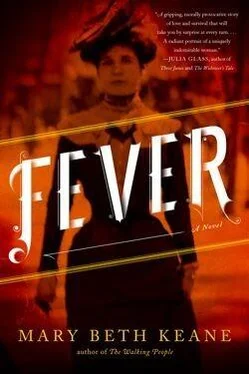One morning, at the end of her second week on North Brother, she looked out from a fourth-floor window to see if she might spot the mail sack being transferred from the ferry and noticed a trio of men framing a small wood structure a short distance away. As soon as she saw it she knew it had something to do with her, and wanted to disown it immediately. Why go to the trouble of building something for a person who will be let go in a few weeks? No, it must be for some other purpose.
“Pardon me,” she said to a passing nurse, and pointed out the window. “Do you know what they’re building?”
“It’s your cottage,” the nurse looked confused. “Didn’t they tell you?”
“Tell me what?”
“You’ll be transferred there once it’s complete. You won’t have to be here with the TB patients anymore.” She smiled gently at Mary as if this might be received as good news. Mary felt as if she’d waded into a lake of cold water and just felt the bottom drop away.
“Why? If they’re going to let me go soon?”
“Did they say that? That they’re going to let you go?”
“Yes, they did,” Mary said quietly as she felt her throat constrict and her body begin to tremble. She stumbled back to her cot and sat at the edge. She calculated back to the day they took her from the Bowen residence — nearly a month. How much more testing did they need to do? She got out a sheet of paper and again wrote to Alfred.
Dear Alfred,
In case you sent a letter in response to my last I wanted to let you know that I haven’t received it. I don’t trust anyone here and maybe you sent it but they didn’t give it to me. They are building a room for me separate from the hospital — just a hundred yards or so away. I don’t know why they would go to that trouble if they’re going to let me go soon. Will you ask around and see if anyone knows of a lawyer who might help? I hope you are getting on fine. I keep thinking that the last time I saw your face we were arguing and it doesn’t sit right that I haven’t heard from you since then. Try again to send a letter, Alfred. It will put my mind at ease.
Love,
Mary
She asked a nurse to post the letter immediately, and one week later, she got a response.
Dear Mary,
I was just sending a response to your first letter when I got your second. I saw the article in the paper and knew the Germ Woman was you since you were supposed to return for the weekend that Saturday night and never did. And also because of them mentioning Oyster Bay. I went up to the Bowens and Frank told me everything. I went straight to Willard Parker but a nurse there told me you’d already been moved to North Brother.
Tell me what I can do. I know things were not so good when we last saw each other but I’m feeling better now, no late nights, and I met a Polish man who has a connection in the water tunnels. We have to think about how to get you off that island. Billy Costello has a rowboat but said the waters around North Brother are too rough and no sane person would risk it. I didn’t believe him at first and went over to the East Side fishery but the fishmongers there all said the same thing. What do they want with you? If they really think you have Typhoid couldn’t they treat you at Willard Parker? Or St. Luke’s?
I’m going to ask around to see who knows a lawyer. Don’t worry.
Alfred
Mary read the letter three times before folding it and placing it carefully on her bedside table. It was the longest letter she’d ever gotten from him in the nearly twenty-two years that she’d known him, and thinking of him sitting down to write it made her more eager to be back home. The room they were building for her had four walls now, a roof, a door, and needed only shingles and a window. Dr. Anderson said she’d be moved in a matter of days. Alfred hadn’t mentioned anything about how he was getting by without her, whether he paid the rent for April, but he knew where she kept the spare cash in their rooms, and maybe that water-tunnel job would be a real lead, maybe he’d love it, maybe he’d find someone who knew exactly how to help her and she’d be back home by summer.
Sometimes they called it a cabin. Sometimes a cottage. A bungalow. A hut. A room. A shack. Whatever it was, they moved her there in April 1907. It was a simple ten-by-twelve-foot structure with a two-burner gas range, a kettle, a sink with running water. They gave her a small box of tea, a bowl of sugar, two teacups. She was not allowed to cook, but prepared food would be delivered from the hospital cafeteria three times a day. To pass the time between visits from medical personnel, Mary was told that she could sew for the hospital, or if she had a knack for crochet, they would provide needles and yarn. She could read. She could explore the island. Mary took all of this information blankly, and as she looked around her new home for the first time, she felt disoriented.
“And linens!” A petite nurse bustled around the small space, showing Mary a wicker basket that held fresh sheets, a towel, a washcloth. “Leave them outside your door when they need to be laundered.”
“How long?” Mary asked. How many times can a person ask the same question?
“In the main building we wash them once a week, so I’d say the same for you.”
“That’s not what I…” Mary sighed, and sat on the edge of the cot. “Will you leave me, please?”
“Almost done.” The nurse lined up a dozen glass canisters on the counter.
When she finally left, and Mary was alone for the first time since they’d captured her, she felt as if she’d left a crowded room and now approached that same room from a different door. She saw herself from a distance: the walls of her hut, the river just beyond, the chuffing of trains and trolleys crisscrossing Manhattan and the Bronx, so close she could hear the whistles. They are not letting me go. She made herself say it aloud. She’d been watching for the mail sack every day, hoping for a letter from Alfred to tell her that he’d found a lawyer, that help was coming, but maybe he already knew that they’d never let her go. Maybe that’s why he hadn’t written again: because he hadn’t known what to say. Unlike other times in her life, when she moved from laundress to cook, or when she moved in with Alfred without a single promise, North Brother felt like a place that was off the map entirely, no footprints left behind for her friends to follow and figure out where she’d gone. Sure, some knew. Those who were there for the arrest, those who helped hide her for all those hours only to be rewarded with a scene they’d talk about for the rest of their lives: a grown woman kicking, cursing, punching, dragged bodily into a police wagon. And there were the articles in the papers, but none of those said how she felt, what she thought. She was certain that word of her arrest had spread among the other cooks and laundresses and gardeners of Manhattan, but like the fast-moving currents that run deep in the ocean without disturbing the surface of the water, Mary was also certain that there were plenty who did not know. It was possible that after her arrest, after their humiliation, the Bowens had never spoken of Mary to anyone but each other. The agency wouldn’t utter a peep for fear of being dropped by other fine homes. The papers would follow her story for a while, but then they would move on, and Mary would still be in her hut, wondering how to get home.
The next morning, after fitful sleep in her new cot, Mary woke to the sound of an envelope sliding under her door. She recognized Alfred’s writing from across the room. She tore it open and stood beside the window to read it.
Dear Mary,
Are you doing all right? Have they said anything more about when you’ll be allowed home? I went up there to see if I could talk the ferryman into bringing me over for a visit but he has his instructions and they are very strict. I offered him money but he wouldn’t take it. I looked across the water to see what it’s like for you out there but it’s hard to tell.
Читать дальше












